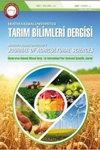小型离心泵恒速与变速运行的能效比较
IF 1.1
4区 农林科学
Tarim Bilimleri Dergisi-journal of Agricultural Sciences
Pub Date : 2016-08-25
DOI:10.1501/TARIMBIL_0000001402
引用次数: 2
摘要
本研究的目的是比较在小型离心泵灌溉系统中不同线路和变速驱动(VSD)使用的流量阀的能源效率。通过使用出口阀、进口阀、旁通阀和VSD进行测试。实验包括4次等速和变速实验,3次恒压实验。在每次测试中,测量了不同流量下的功耗、进口压力和出口压力。在工作点附近的等速试验中,旁路阀比出口阀和进口阀分别节能66%和5%。将流量降低20%,同时使用旁通阀和进口阀可减少7%的能耗,使用出口阀可减少19%的能耗。与恒速测试中使用的阀门相比,VSD的使用显示出了巨大的优势,与旁通阀、进口阀和出口阀相比,VSD的能源需求分别减少了41%、44%和80%。此外,还比较了VSD和旁通阀在恒压工况下的性能。在4.0 bar到2.5 bar的压力范围内,VSD的能耗降低了2%到37%。在高流量时,节省的成本较少,随着流量需求的降低,节省的成本迅速增加。在恒速试验中发现的低系统效率表明,该泵不适合用于低压应用的液压系统。恒压试验表明,VSD的系统效率(26-29.1%)高于旁通阀的系统效率(21.3-25.5%)。综上所述,VSD是最节能的方法,在小型动力泵系统中可以显著节省能源。本文章由计算机程序翻译,如有差异,请以英文原文为准。
Comparison of Energy Efficiencies of a Small Centrifugal Pump at Constant and Variable Speed Operations
The objective of this study was to compare the energy efficiencies of flow rate valves used in different lines and variable speed drive (VSD) in a small centrifugal pump irrigation system. The tests were done by using an outlet valve, inlet valve, by-pass valve, and VSD. The study included four replications of constant speed and variable speed experiments, and three replications of constant pressure experiments. In each test, power consumption, inlet pressure, and outlet pressure were measured at different flow rates. During the constant speed tests at about the operating point, by-pass valve saved energy up to 66% and 5% compared to the outlet valve and inlet valve, respectively. Reducing the flow rate by 20% resulted in 7% less energy consumption with the use of both the by-pass valve and the inlet valve, and 19% more energy consumption with the outlet valve. The use of VSD showed profound advantage over the valves used in constant speed tests, with 41%, 44%, and 80% less energy demand compared to the by-pass, inlet, and outlet valve, respectively. Also, VSD and by-pass valves were compared in constant pressure operations. VSD offered 2 to 37% less energy consumption at pressures from 4.0 bar to 2.5 bar. The savings were less at high flow rates and quickly increased as the flow rate need decreased. The low system efficiency found in constant speed tests suggested that the pump was not appropriate for the hydraulic system used in low pressure applications. According to constant pressure tests, the system efficiency for VSD (26-29.1%) was greater than that of the by-pass valve (21.3-25.5%). In conclusion, the VSD was the most energy efficient method and suggested significant energy savings in small powered pump systems.
求助全文
通过发布文献求助,成功后即可免费获取论文全文。
去求助
来源期刊
CiteScore
1.40
自引率
0.00%
发文量
26
期刊介绍:
Journal of Agricultural Sciences (JAS) is an international, double-blind peer-reviewed, open-access journal, published by the Faculty of Agriculture, Ankara University. The journal invites original research papers containing new insight into any aspect of Agricultural Sciences that are not published or not being considered for publication elsewhere. Preliminary, confirmatory or inconclusive research, review articles, case and local studies and works presenting taxonomy will not be published.

 求助内容:
求助内容: 应助结果提醒方式:
应助结果提醒方式:


